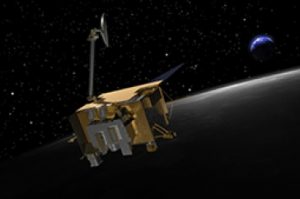16 March 2018
New study finds space radiation is increasingly more hazardous
Posted by Nanci Bompey
By Robbin Ray

Artist’s rendition of the Lunar Reconnaissance Orbiter at the moon. The CRaTER telescope is seen pointing out at the bottom right center of the LRO spacecraft.
Credit: NASA’s Goddard Space Flight Center Conceptual Image Lab
It might sound like something from a science fiction plot – astronauts traveling into deep space being bombarded by cosmic rays – but radiation exposure is science fact. As future missions look to travel back to the Moon or even to Mars, new research cautions that the exposure to radiation is much higher than previously thought and could have serious implications on both astronauts and satellite technology.
“The radiation dose rates from measurements obtained over the last four years exceeded trends from previous solar cycles by at least 30 percent, showing that the radiation environment is getting far more intense,” said Nathan Schwadron, professor of physics at the University of New Hampshire’s Space Science Center and lead author of the new study. “These particle radiation conditions present important environmental factors for space travel and space weather, and must be carefully studied and accounted for in the planning and design of future missions to the moon, Mars, asteroids and beyond.”
In their study, recently published in the journal Space Weather, a publication of the American Geophysical Union, the researchers found that large fluxes in Galactic Cosmic Rays (GCR) are rising faster and are on path to exceed any other recorded time in the space age. They also point out that one of the most significant Solar Energetic Particle (SEP) events happened in September 2017 releasing large doses of radiation that could pose significant risk to both humans and satellites. Unshielded astronauts could experience acute effects like radiation sickness or more serious long-term health issues like cancer and organ damage, including to the heart, brain, and central nervous system.
In 2014, Schwadron and his team predicted around a 20 percent increase in radiation dose rates from one solar minimum to the next. Four years later, their newest research shows current conditions exceed their predictions by about 10 percent, showing the radiation environment is worsening even more than expected.
“We now know that the radiation environment of deep space that we could send human crews into at this point is quite different compared to that of previous crewed missions to the moon,” says Schwadron.
The authors used data from CRaTER on NASA’s Lunar Reconnaissance Orbiter (LRO). Lunar observations (and other space-based observations) show that GCR radiation doses are rising faster than previously thought. Researchers point to the abnormally long period of the recent quieting of solar activity. In contrast, an active sun has frequent sunspots, which can intensify the sun’s magnetic field. That magnetic field is then dragged out through the solar system by the solar wind and deflects galactic cosmic rays away from the solar system – and from any astronauts in transit.
For most of the space age, the sun’s activity ebbed and flowed like clockwork in 11-year cycles, with six- to eight-year lulls in activity, called solar minimum, followed by two- to three-year periods when the sun is more active. However, starting around 2006, scientists observed the longest solar minimum and weakest solar activity observed during the space age.
Despite this overall reduction, the September 2017 solar eruptions produced episodes of significant Solar Particle Events and associated radiation caused by particle acceleration by successive, magnetically well-connected coronal mass ejections. The researchers conclude that the radiation environment continues to pose significant hazards associated both with historically large galactic cosmic ray fluxes and large but isolated SEP events, which still challenge space weather prediction capabilities.
— Robbin Ray is a media relations specialist at the University of New Hampshire. This post originally appeared as a press release on the UNH website.


 GeoSpace is a blog on Earth and space science, managed by AGU’s Public Information staff. The blog features posts by AGU writers and guest contributors on all sorts of relevant science topics, but with a focus on new research and geo and space sciences-related stories that are currently in the news.
GeoSpace is a blog on Earth and space science, managed by AGU’s Public Information staff. The blog features posts by AGU writers and guest contributors on all sorts of relevant science topics, but with a focus on new research and geo and space sciences-related stories that are currently in the news.
What is the range of dosages, both total and per unit time? I worked at a national laboratory. Although not regularly exposed, I did take my annual maximum dose during an 15-minute emergency procedure
Why do brilliant people, like Elon Musk and NASA scientists, still plan to send humans to the moon and Mars, when such ventures have a high probability of lethally irradiating them, since no present technology would provide adequate protection from ionizing radiation?